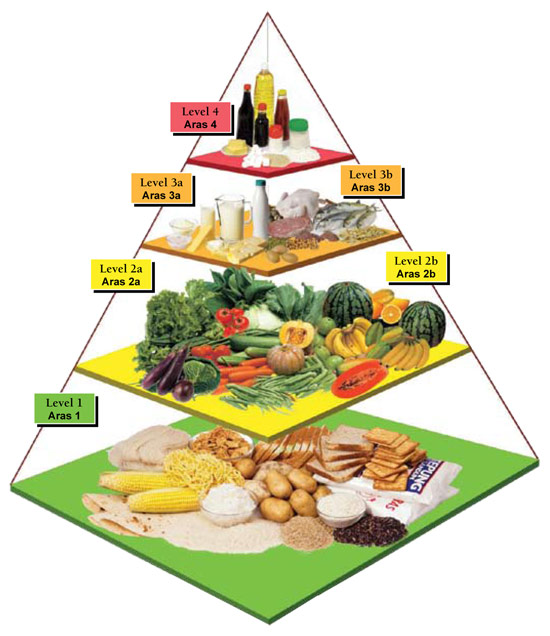Over the past decades, portion sizes of food sold in eateries have grown considerably, leading to misconceptions on how moderate serving sizes should actually be. Even when we eat at home, servings of meals have become larger. Unfortunately, the increase in portion sizes also has a direct impact on the increasing waistlines of many Malaysians. The National Health and Morbidity Survey in 2006 showed that two out of every five adults, or 43%, were either overweight or obese. This figure is significantly higher than the findings in a similar survey 10 years before!
Balanced portions need moderation and variety…
In general, the key to a healthy diet and weight management is eating varied, well-balanced meals in moderate portions. But how many of us know what an actual serving size looks like? How much should we eat? How much should we feed our children?
The Malaysian Food Pyramid is a simple and practical tool which will help you understand how much food is recommended every day from each of the five main food groups (Level 1 – 3b only). The pyramid will help you and your family to achieve:
Balance – Serve foods from all the five types of food groups daily. Foods at the bottom of the food pyramid should be eaten adequately, while those at higher levels should be eaten in a proportionately smaller amount. Each food group performs different main functions, and the right combination is essential for optimal health.
Moderation – Follow the recommended number of servings to avoid overeating, which may lead to overweight and obesity. Each time you serve a plate of rice to your child, be mindful of the serving size so that you do not serve too much (or too little).
Variety – Ensure that you serve a mix of foods from each level of the pyramid, as no single food can give you all the nutrients that you need.
Understand what’s in a serving…
You should serve food from each food group according to the following recommended serving sizes:
| Food Groups | Recommended Servings Per Day | What’s a Serving / How Much to Serve |
|---|---|---|
| Level 1 – Grains & their Products | Eat adequately. 4 to 8 servings of these foods per days |
2 slices of bread, 2 whole potatoes, 2 scoops of cooked rice or 1 cup of wet noodles |
| Level 2a – Vegatables | Eat more. 3 servings per days |
1 cup of leafy vegetables, ½ cup of other vegetables Tip: About size of your palm |
| Level 2b – Fruits | Eat more. 2 servings per days |
1 medium apple, 1 medium banana, ½ glass of fruit juice Tip: About size of a tennis ball |
| Level 3a – Fish, Poultry, Meat, Eggs, Dry Beans and Nuts | Eat moderately. 2 servings per day. |
Approximately 120g of lean red meat or poultry, 170g of white fish, 1 cup of beans (120g) |
| Level 3b – Milk and Dairy Products | Eat moderately. 1 to 3 servings per day. |
1 glass (200ml) of milk, 1 small cup (150g) of yoghurt, 1 slice of cheese |
| Level 4 (Not considered a food group) Oils, Fats, Sugar and Salt | Foods high in these ingredients should be consumed sparingly. |
Helpful Tips!
|






Comments